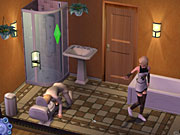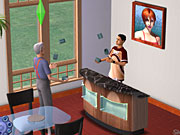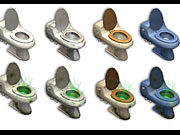The Sims 2 Designer Diary #4
Several members of Maxis' creative team discuss the process of creating furniture and other items for The Sims 2.
Designing Stuff for The Sims 2
Tim LeTourneau - Senior ProducerBrooke Harris - Associate Producer
Matt Brown - Technical Director
Charles London - Creative Director
Patrick Barrett - Game Designer
Claire Curtain - Game Designer
One of the reasons The Sims appeals to so many people is that so many people contribute to what the game becomes. We thought it would be cool to give everyone an opportunity to be a fly on the wall at Maxis. For instance, one of the things that a lot of people don't realize is the amount of detail that goes into designing and making virtual objects and furniture. Below, you'll find a summary of the kind of meetings we hold as we develop The Sims 2. This particular meeting begins with the discussion of a most essential fixture: the toilet.
Tim: "OK guys...why do we need it?"
Brooke: "Well, we could start with bladder motive."

Believe it or not, we have to decide with each object whether or not we need it and what its purpose is. The toilet is kind of a no-brainer. Sims have this thing called a "bladder motive," and it's got to be taken care of. Now, anyone who has played The Sims knows that sims are perfectly happy using the floor, but I think we'd all prefer they didn't, so the toilet is an obvious choice.
Tim: "OK, we need it. What do the sims do with it?"
Again, it seems obvious, but it's a discussion we have to have.
Matt: "OK, so the sim needs bladder relief. They [head over] to the toilet. If there is anyone in the room they 'shoo' those people out."
Brooke: "Wait, what about spouses? I don't send my husband out of the room when I use the toilet."
Charles: "OK, too much info, Brooke."
Laughs break out around the room.
Claire: "No, you're right. They shouldn't shoo out sims [with a high relationship rating]. So they will use it in front of them."
Brooke: "What does the player see?"
Patrick: "Well, they have to be pixelated."
Brooke: "Whole body or just parts?"
The team eventually decides to "censor" out only parts of a sim's body, while using the restroom, for comedic effect. The team then discusses how items, like the latrine, can be used to further The Sims 2's more-detailed memory and relationship systems. Do sims have "favorite" items they'll tend to use more often, and will the use of those items affect their interpersonal relationships? The sequel will actually have a "reaction system" that will govern a sim's reaction to a stimulus, like seeing an object in a certain state. There is a tremendous amount of detail that goes into the design of each and every object for The Sims 2. But it's not just the objects.
One of our goals is to clearly express the personalities of sims and to make each sim feel unique in The Sims 2. We want to let players play "normal" sims with recognizable personalities, but we also want them to be able to play more "extreme" sims if they're in the mood to push the envelope. Players should also have to think about the personalities of their sims in relation to each other. If they put an incredibly neat sim and a really sloppy sim in the same house, players should have to work at it to make things run smoothly.
Juggling Personality Traits

To make this all happen, we have had to define each of the personality "archetypes" in The Sims 2. In the original game, Sims had five personality "pairs": mean/nice, sloppy/neat, lazy/active, shy/outgoing, and serious/playful. Since players are already familiar with those categories and they still seemed to cover the basics, we started with them as our base. We then needed to identify the game dynamics and interactions that would define a particular axis or extreme. We started with playful sims.
Tim: "OK guys. Give me some words that describe a playful sim."
The team then contributes the following:
Carefree
Funny
Creative
A good sport
Flexible
Experimental
Easily distracted
Naked
Tim: "OK, that's not playful, that's promiscuous. So...playful Sims..."
Claire: "They should play with everything."
Matt: "They could jump up and down on the couch!"
Tim:"They'd need to bounce up and down too. And be annoyed. And stare at them as they jump up and down. They need to be aware of what's going on, or it won't work."
Brooke: "Ooo! And serious sims should really hate it."
Patrick: "Maybe all unique playful interactions could make serious sims' fun and comfort motives decrease."
Brooke: "Feels like sims should have issues with personalities that are 'opposed' to theirs."
Matt: "Can we make other sims on the couch bounce no matter what they're doing?"
Tim: "Yep. Should be able to make that work. Jumping up and down satisfies their fun motive then."
Brooke: "Do they just do it once, or do they do it until they're tired?"
Claire: "The player should be able to park 'em in it until they've satisfied a certain tunable amount of fun...then they land on the couch and sit."
Tim:"Cool. What else?"
Matt: "They should be able to juggle."
Tim: "Just balls, or other things?"
Patrick: "They could juggle balls as an 'entertain' social, but what about other objects?"
Tim: "If we want playful sims to feel playful from the start, they should have special interactions with everyday things."
Matt: "They could juggle coffee cups, or espresso cups, or the espresso machine. Or babies..."
Brooke: "I don't think we can juggle babies... I mean, we can technically juggle babies, but I think we should stick to things that can be dropped without getting us angry letters."
Matt: "They should be able to do tricks based on their playfulness and mechanical skill...or their creative skill..."
Claire: "Could they juggle with someone else?"
Tim: "Ah! Juggling could be joinable... Tthen another sim could join in once a playful sim gets going. Cool."
Brooke: "Then they'd get social as well as fun, ... which is more efficient for time management..."
Again, ...we think you get the idea. When we feel like we've got enough to work with, we write it all down and sift through it to come up with the best set of interactions that would make a playful sim truly playful. 
A lot of time and effort go into the details of The Sims 2. And that's just the beginning. After the brainstorming, we have to design the object properly. We need to identify the motive effects of each interaction and work out the relationship between the various interactions and the underlying subsystems that make the sims tick, like reactions, autonomous interaction choice, motive decay, and motive satisfaction from other objects. Maybe in our next meeting, we'll discuss bathtubs and mean sims.
Got a news tip or want to contact us directly? Email news@gamespot.com

Join the conversation